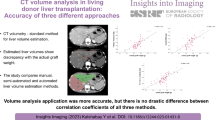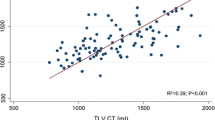Abstract
Of readily available methods to estimate the donor liver size, measurement of the body circumference at the xiphoid level (xiphoid measure) appeared to be the most accurate in the present prospective study of 60 donors and 57 recipients (r = 0.64, P = 0.0001). The estimated liver volume could be calculated using the equation: bloodless liver volume (1) = 1.44 × xiphoid measure (m). The difference between donor and recipient xiphoid measures was significantly higher in slowly recovering patients than in those recovering uneventfully (7 ± 7 cm vs. — 5 ± 8 cm, P < 0.001). The bloodless donor liver volume measured by water displacement averaged 1249 ± 230 ml and had increased by 3 weeks posttransplant by 64 ± 28% as determined using computed tomography. The volume of the liver graft seemed to adapt to the recipient as it correlated positively with body weight (r = 0.64, P < 0.01) and negatively with the age of the recipient (r = −0.42, P < 0.01). The liver graft volume seemed to increase less markedly in patients with a slow recovery than in those with an uncomplicated recovery (37% ± 15% vs. 68% ± 24%, P < 0.001). We conclude that a simple measurement of the body circumference at the xiphoid level can be used to estimate the donor liver volume. A gross mismatch of this parameter between the donor and the recipient seems to increase the risk of graft dysfunction. We also found that the change in the liver graft volume is influenced by the recipient’s age and body weight.
Access this chapter
Tax calculation will be finalised at checkout
Purchases are for personal use only
Preview
Unable to display preview. Download preview PDF.
Similar content being viewed by others
References
Adam R, Castaing D, Bismuth H (1993) 6. Transplantation of small donor livers in adult recipients. Tranpslant Proc 25: 1105–1106
DuBois D, DuBois EF (1916) A for- 7. mula to estimate the approximate surface area if height and weight be known. Arch Intern Med 17: 863–871
Heymsfield SB, Fulenwider T, Nordlin- 8. ger B, et al (1979) Accurate measurement of liver, kidney, and spleen volume and mass by computerized axial tomography. Ann Intern Med 90: 185–187
Kam I, Lynch S, Svanas G, et al (1987) 9. Evidence that host size determines liver size: studies in dogs receiving orthotopic liver transplant. Hepatology 7: 362–366
LeLand FH, North WA (1968) Rela- 10. tionship between liver size and body size. Radiology 91: 1195–1198
Leung NWY, Farrant P, Peters TJ (1986) Liver volume measurement by ultrasonography in normal subjects and alcoholic patients. J Hepatol 2: 157–164
Marchesini G, Bua V, Brunori A (1988) Galactose elimination capacity and liver volume in aging man. Hepatology 8: 1079–1083
Payen DM, Fratacci MD, Dupuy P, et al (1990) Portal and hepatic arterial blood flow measurements of human transplanted liver by implanted Doppler probes: interest for early complications and nutrition. Surgery 107: 417–427
Ploeg RJ, D’Alassandro AM, Knechtle SJ, et al (1993) Risk factors for primary dysfunction after liver transplantation–a multivariate analysis. Transplantation 55: 807–813
Sato H, Takase S, Takada A (1989) Changes in liver and spleen volumes in alcoholic liver disease. J Hepatol 8: 150–157
Shiraishi M, Csete ME, Yasunaga C, et al (1994) Regeneration-induced accel- erated rejection in reduced-size liver grafts. Transplantation 57: 336–340
Tarao K, Hoshino H, Motohashi I (1989) Changes in liver and spleen volume in alcoholic liver fibrosis of man. Hepatology 9: 589–593
Urata K, Kawasaki S, Matsunami H, et al (1995) Calculation of child and adult standard liver volume for liver transplantation. Hepatology 21: 1317–1321
Wynne HA, Cope LH, Mutch E, et al (1989) The effect of age upon liver volume and apparent liver blood flow in healthy man. Hepatology 9: 297–301
Yamanaka N, Okamoto E, Kawamura E, et al (1993) Dynamics of normal and injured human liver regeneration after hepatectomy as assessed on the basis of computed tomography and liver function. Hepatology 18: 79–85
Author information
Authors and Affiliations
Editor information
Editors and Affiliations
Rights and permissions
Copyright information
© 1996 Springer-Verlag Berlin Heidelberg
About this paper
Cite this paper
Mäkisalo, H., Salmela, K., Isoniemi, H., Tierala, E., Höckerstedt, K. (1996). How to estimate the size of the donor liver. In: Mühlbacher, F., et al. Transplant International . Springer, Berlin, Heidelberg. https://doi.org/10.1007/978-3-662-00818-8_48
Download citation
DOI: https://doi.org/10.1007/978-3-662-00818-8_48
Publisher Name: Springer, Berlin, Heidelberg
Print ISBN: 978-3-540-61024-3
Online ISBN: 978-3-662-00818-8
eBook Packages: Springer Book Archive




